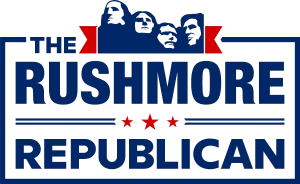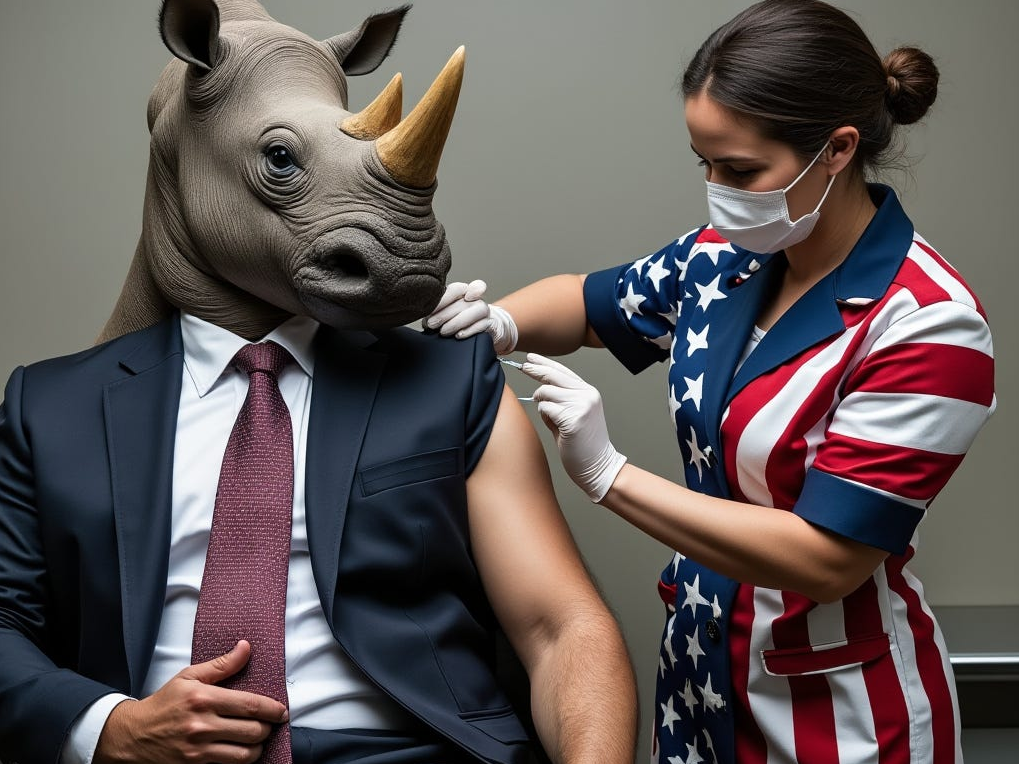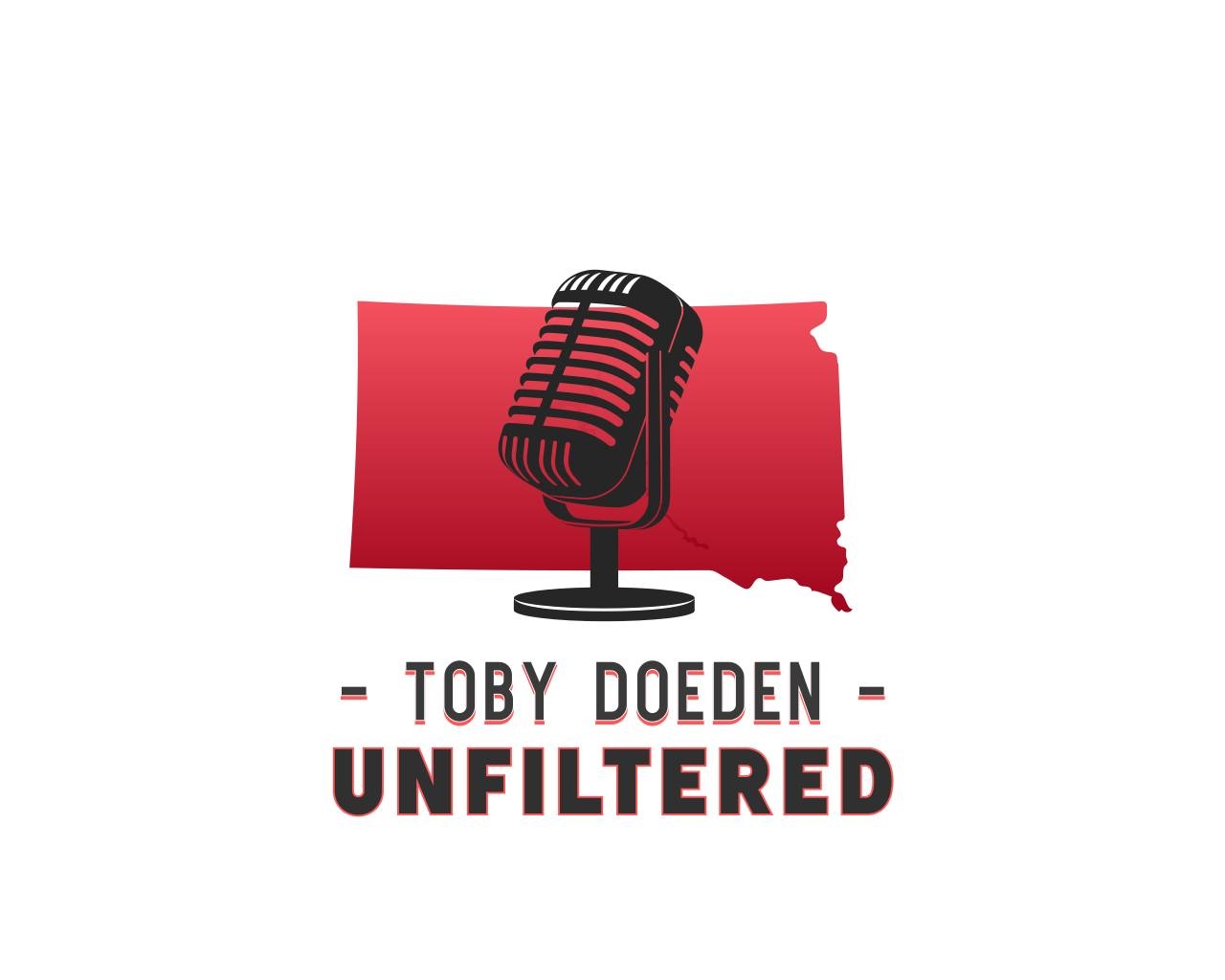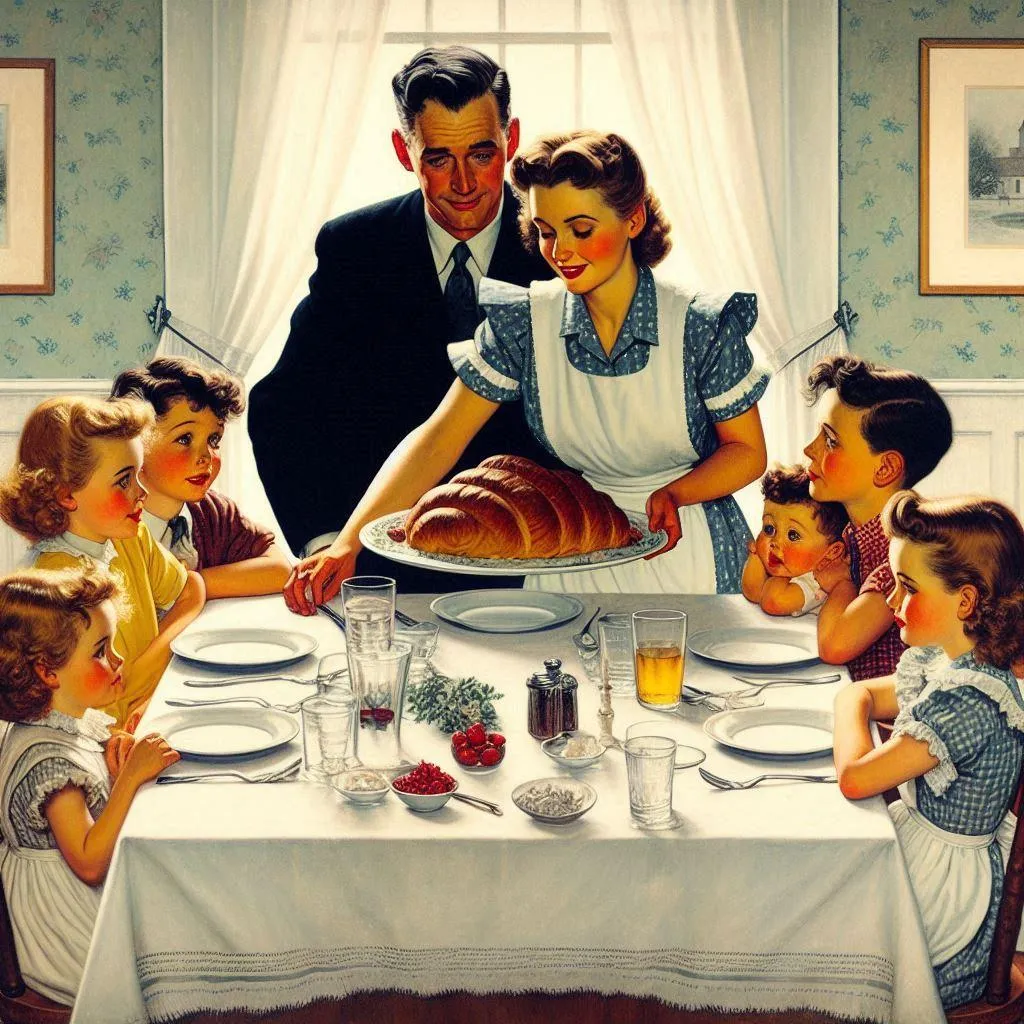
Hello Readers! This is my last brief of the four briefs I wrote to the S.D. Supreme Court. I did not write this like a lawyer but as a citizen telling an honest story. Keep in mind the illegal election conducted did not only effect my individual race but the entire Lawrence County Primary election. I don’t believe I will receive justice for this in our court system yet this is now on the record to the highest authority
STATEMENT OF THE CASE
The order I am appealing was submitted by Judge Jeffery Connelly within the Fourth Circuit Court. The order was regarding a Verified Petition for a recount I had filed on June 11th, 2024 for the primary District 31 South Dakota Senate race in which I was a candidate on June 4th, 2024.
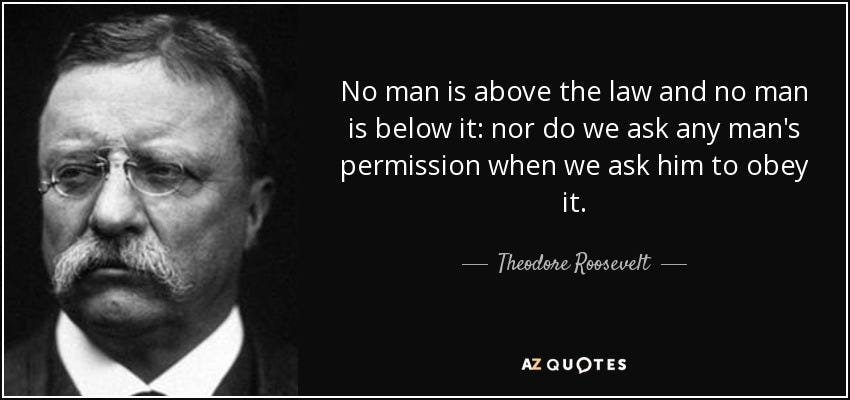
STATEMENT OF THE FACTS
I was a candidate for District 31 South Dakota Senate. The primary was held on June 4th, 2024. The Auditor has taken a written oath to the S.D. Constitution and the United States Constitution. She was required to conduct a legal election. I submitted a petition for a recount on June 11th, 2024, to the Lawrence County Auditor Brenda McGruder. I had a legal constitutional right to petition my grievances about the Auditor breaking the testing laws that are used to certify the computerized tabulators pursuant to U.S. Const. amend. I The Auditor did not want to accept and file my Verified Petition due to SDCL 12-21-10. I have an email confirmation of her denial based on SDCL 12-21-10. Her refusal of my Verified Petition was wrong because the Auditor had done the test deck illegally. The Auditor had the physical proof, the election statutes, and the administrative rules on how to conduct a legal test, but failed to. Test decks are used by all auditors in the state of South Dakota to test the computerized tabulators before certifying the tabulators before each election. The Company of ES&S provided the illegal test deck that violated their own computerized tabulator manual titled EVS 6042 CA Election Management and in Chapter 5, it is clear what the guidance is from ES&S, in their recommendation and guidance to use a sequential number of votes for each office, which complements SDCL 12-17b-5.1 requiring, “a different number of valid votes must be assigned to each candidate for an office and for and against each measure.” This is a fact that can easily be proven because these test decks are physical proof. Judge Connelly never asked me or called for any witnesses to testify why it was illegal during the Recount Hearing. I submitted the illegal test deck and manual on how to read it with my Verified Recount Petition. In the Recount Hearing Judge Connelly stated he did not necessarily want to submit evidence to the hearing. He ignored all evidence of an illegal test deck and other illegal activity that the Auditor had achieved. The computer tabulators are required to be certified before each election and to be found errorless according to SDCL 12-17B-5; “Testing system before election–Certification of errorless machine–Promulgation of rules–Public notice–Independent candidate and ballot committee contact information.” This is the auditor’s job, and she should have known what a legal test deck was after being our Auditor for several years. The Auditor also failed to test one of the computer tabulators on the public testing day that is pursuant to S.D. Secretary of State Administrative Rules 5:02:09:01.02. This rule is used for the front line in catching programming issues and establishing confidence. If more than one tabulating machine is to be used in the election, each machine must be fully tested on any ballot that each machine will be used to count in the election. The e-mail from the Auditor states, “I have attached the reports from 5-29-2024 Tab Test. The precinct-by-precinct reports for Machine A were not run on 5-29-2024, but I included the tests that were run on each machine on election day prior to running any election day ballots pursuant to SDCL 12-17B-12.” The Certificates on these tabulators are dated May 29th, 2025. The auditor stamps and signs certifications on each of the two tabulators yet she had not even tested tabulator “A” with the illegal test deck until election day of June 4th, 2024. Since all Recount Petitions are sent to the Fourth Circuit Court and given a docket number by the clerk of courts in order for the Circuit Court to decide, I went directly to the clerk of courts and filed my verified petition on June 11th, 2024. Then Auditor McGruder was served the verified petition by the Sheriff’s Department that she refused to file and forward to the clerk of court’s office, so the clerk of court’s office could assign a docket number and forward it to the Circuit Court judge as done in all verified petitions for a recount. The Auditor never admitted to her wrongdoing of illegally certifying the two computerized tabulators and had no intention of allowing me to petition for a justifiable grievance. I submitted to the Circuit Court the “Declaration of Rick Weible” which was written about the illegal test deck and his bio information as an election expert who is a certified network engineer with 28 years of experience as a cybersecurity consultant with an impressive background. In this declaration, Rick Weible declares that after reviewing half of the test deck, the Auditor performed 45 violations. When Rick Weible is done reviewing it can easily be predicted that it will be over 100 violations. Rick Weible’s declaration explains why it should be hand-recounted and that the votes could have been completely flipped. Judge Connelly ignored this and the South Dakota Constitution but instead focused on SDCL 12-21-10, which requires the candidates to be within two percent to recount an election even though the votes could have been flipped. In the hearing, Judge Connelly repeated the result was an eighteen percent difference based on the illegal activity of certifying the computer tabulators illegally and against the DS 450 tabulator manual titled EVS 6042 CA Election Management. I also submitted the illegal test deck and a manual that explains what a legal proper test deck is and what it is not. Judge Connelly never inquired or asked questions on the evidence I submitted with my Petition to Recount. Judge Connelly’s order he signed, was written by Mr. Williams and states that I conceded with the election results. This is a lie. I stated at the hearing that the Auditor violated laws in the testing. I told Judge Connelly that we do not know what the legal results are because the computer tabulators were illegally certified. My entire Verified Petition that was notarized confirms my entire reasoning and complaint. When I attended the Recount hearing, I did not concede to the election results that were the result of illegal testing and certification, even though Judge Connelly tried to get me to concede to the results. I stated, “I did not agree with him.” I made sure to ask witnesses to come to the hearing to verify what I said. The Fourth Circuit Court was the jurisdiction for a “Recount Petition” and not the S.D. Legislature.

ARGUMENT
It was obvious from the start of this petition for a recount that I knew SDCL 12-21-10 was unconstitutional. It was also very apparent from my actions that I believed I had the legal right to petition for my well-founded grievances according to U.S. Const. amend. I. My grievances were about factual illicit activity done by the election official. I even expressed to the auditor that SDCL 12-21-10 should not be the only reason allowed for a recount. S.D. Const. art. VII §1 and S.D. art. VI §19 Bill of Rights states we are to have fair and equal elections that are not to be interfered with by anyone. This would include auditors, commissioners, lawyers, and judges. Not even a judge has the right to aid and abet the interference of that constitutional right. ES&S EVS 6042 CA Election Management Manual is publicly available in the state of California, and in Chapter 5, it is clear what the guidance is from ES&S, in their recommendation and guidance to use a sequential number of votes for each office, which complements South Dakota Codified law requiring, “a different number of valid votes must be assigned to each candidate for an office and for and against each measure.” Pursuant to SDCL 12-17b-5.1; Each option does not have a unique number assigned from any other option in the senate contest, house representative contest, commissioner contest, and delegate. With unique numbers, we can determine if votes are flipped. In The Declaration by expert Rick Weible, he explains all of this and he explains that after examining only half the test deck that the Auditor performed illegally 45 violations but can easily be estimated at over 100 violations when he is done examining the entire test deck. That means it was never proven to not have errors because of illegal testing. The two DS 450 computer tabulators were illegally certified. The person in charge of the election may not approve the automatic tabulating equipment until an errorless count is made in accordance with SDCL 12-17B-5;
“Not more than ten days prior to an election, the person in charge of the election shall conduct a test of the automatic tabulating equipment to ascertain that the equipment will correctly count the votes cast for all offices and on all measures. The test must be open to the public. The person in charge of the election shall notify the county chair of each political party with a candidate on the ballot, any independent candidate or candidate without party affiliation on the ballot, and the ballot question committees for or against an initiated or referred measure or initiated constitutional amendment of the testing of the automatic tabulating equipment one week before the test is conducted. The person in charge of the election shall post notice of the time and place of the test in the same manner as a public meeting agenda, pursuant to § 1-25-1.1.
If an errorless count by an automatic tabulating machine is achieved by the test, the person in charge of the election shall certify the machine. The State Board of Elections shall promulgate rules, under chapter 1-26, prescribing the certification of properly functioning automatic tabulating equipment under this section.
If an error is detected, the cause of the error shall be determined and corrected. Once the error is corrected, the person in charge of the election shall conduct a new test of the automatic tabulating equipment. The person in charge of the election may not approve the automatic tabulating equipment until an errorless count is made.
Any additional testing required to achieve an errorless count must be open to the public. The person in charge of the election shall post notice of the time and place of an additional test in the same manner as a public meeting agenda, pursuant to § 1-25-1.1. The person in charge of the election shall notify the county chair of each political party with a candidate on the ballot, any independent candidate or candidate without party affiliation on the ballot, and the ballot question committees for or against an initiated or referred measure or initiated constitutional amendment of the testing of the automatic tabulating equipment twenty-four hours prior to the test.
The secretary of state shall provide each county auditor with the contact information for any independent candidate, a candidate without party affiliation appearing on the ballot, and the ballot question committees for or against an initiated or referred measure or initiated constitutional amendment in the auditor’s county.
Source: SL 1994, ch 110, § 9; SL 2023, ch 49, § 1.” Please take note that this is not a recent implemented law even though it has been updated.
The Auditor did not test the second computer tabulator labeled “A” on public testing day. The only one tested with the improper illegal test deck was the computer tabulator labeled “E”. The actual test deck date and time support the fact that the second computer tabulator was not tested on public testing day. If more than one tabulating machine is to be used in the election, each machine must be fully tested on any ballot that each machine will be used to count in the election. The email from the Auditor to me states, “I have attached the reports from 5-29-2024 Tab Test. The precinct-by-precinct reports for Machine A were not run on 5-29-2024 but I included the tests that were run on each machine on election day prior to running any election day ballots pursuant to 12-17B-12.” The Certificates on these tabulators are dated May 29th, 2025. The auditor stamps and signs certifications on each of the two tabulators yet she had not even tested tabulator “A” with the illegal test deck until election day of June 4th, 2024. Additionally, the Auditor broke line number (5) which is included in SD SOS Rule 5:02:09:01.02. The Auditor did not test all the ballot types nor did the Auditor test 10% of the folded ballots when testing the tabulating equipment.
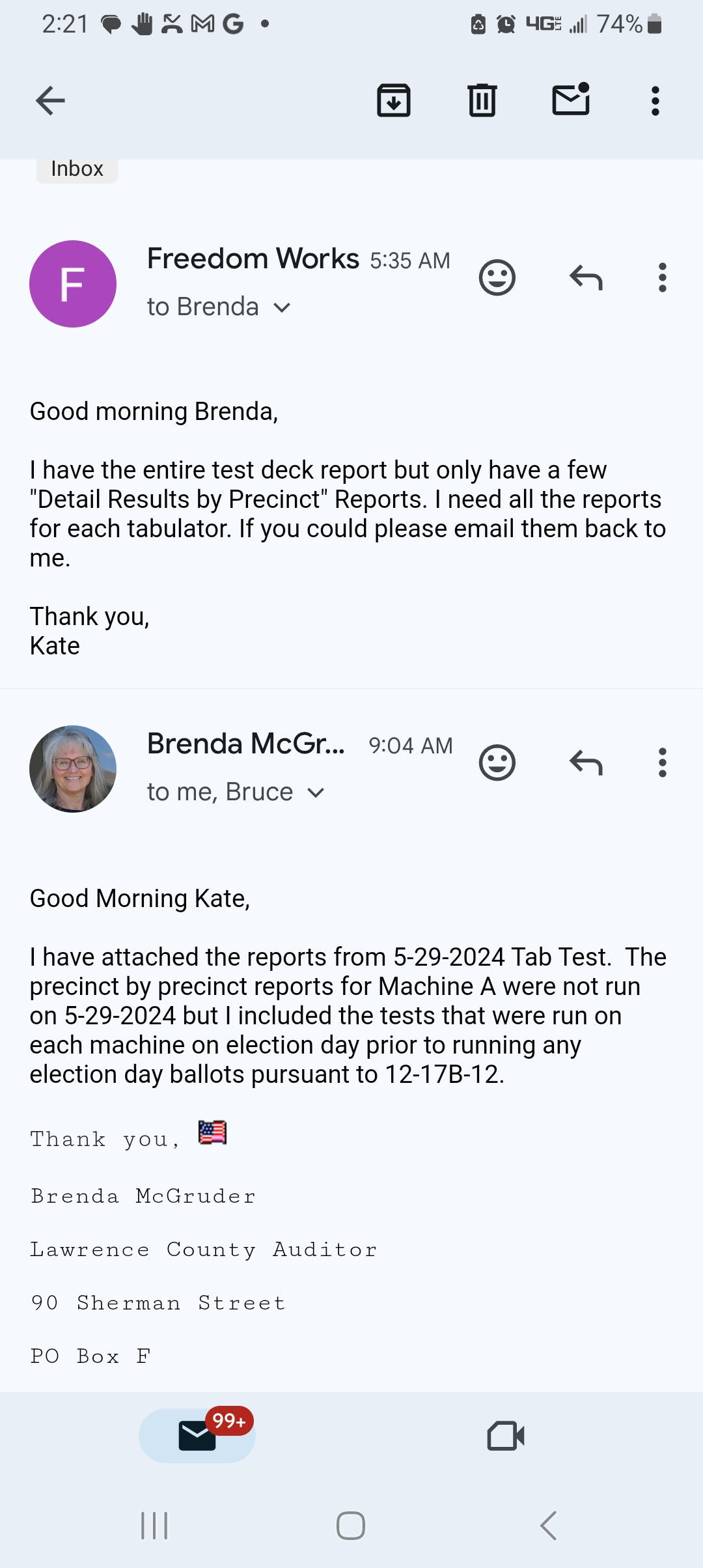
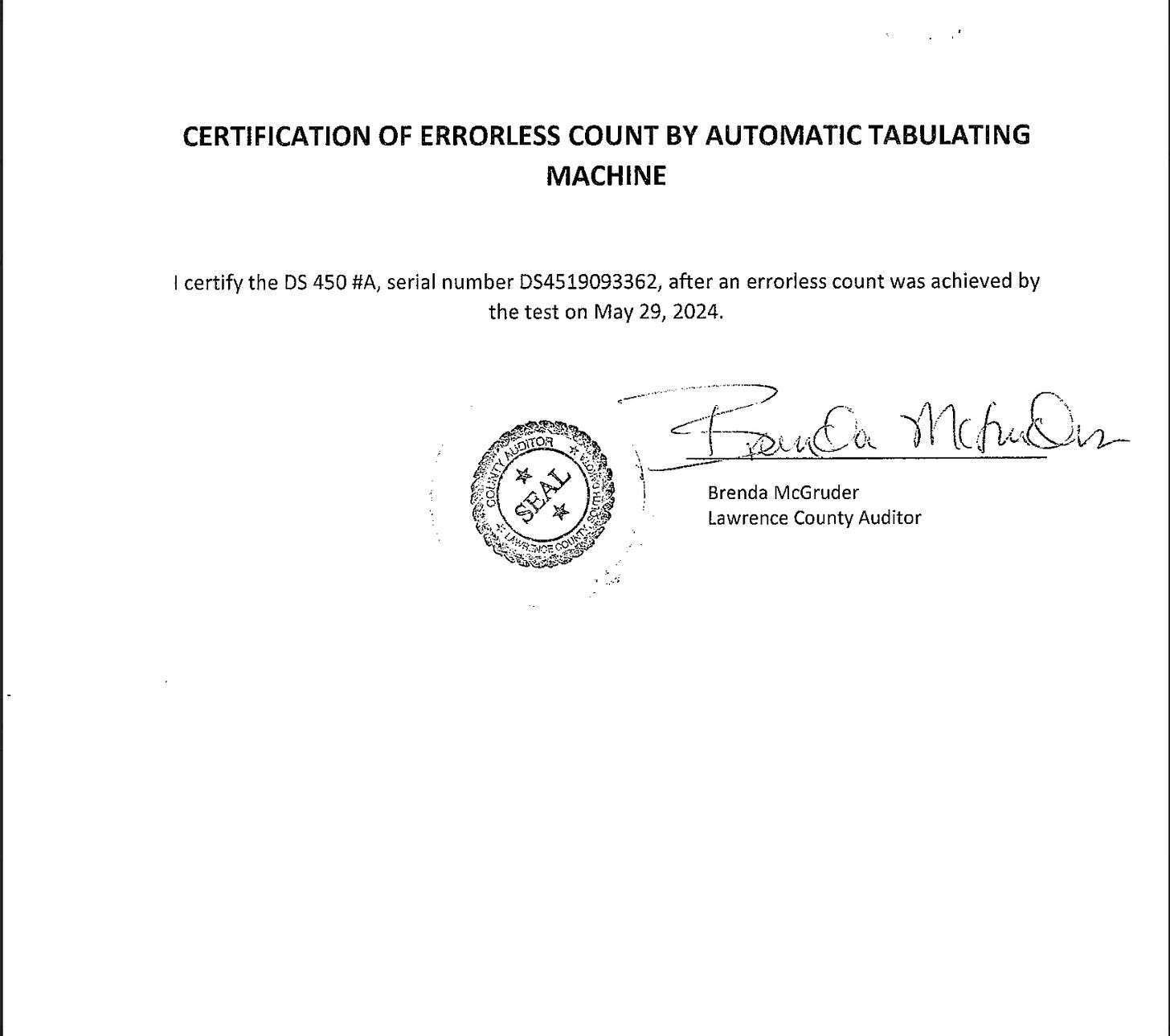
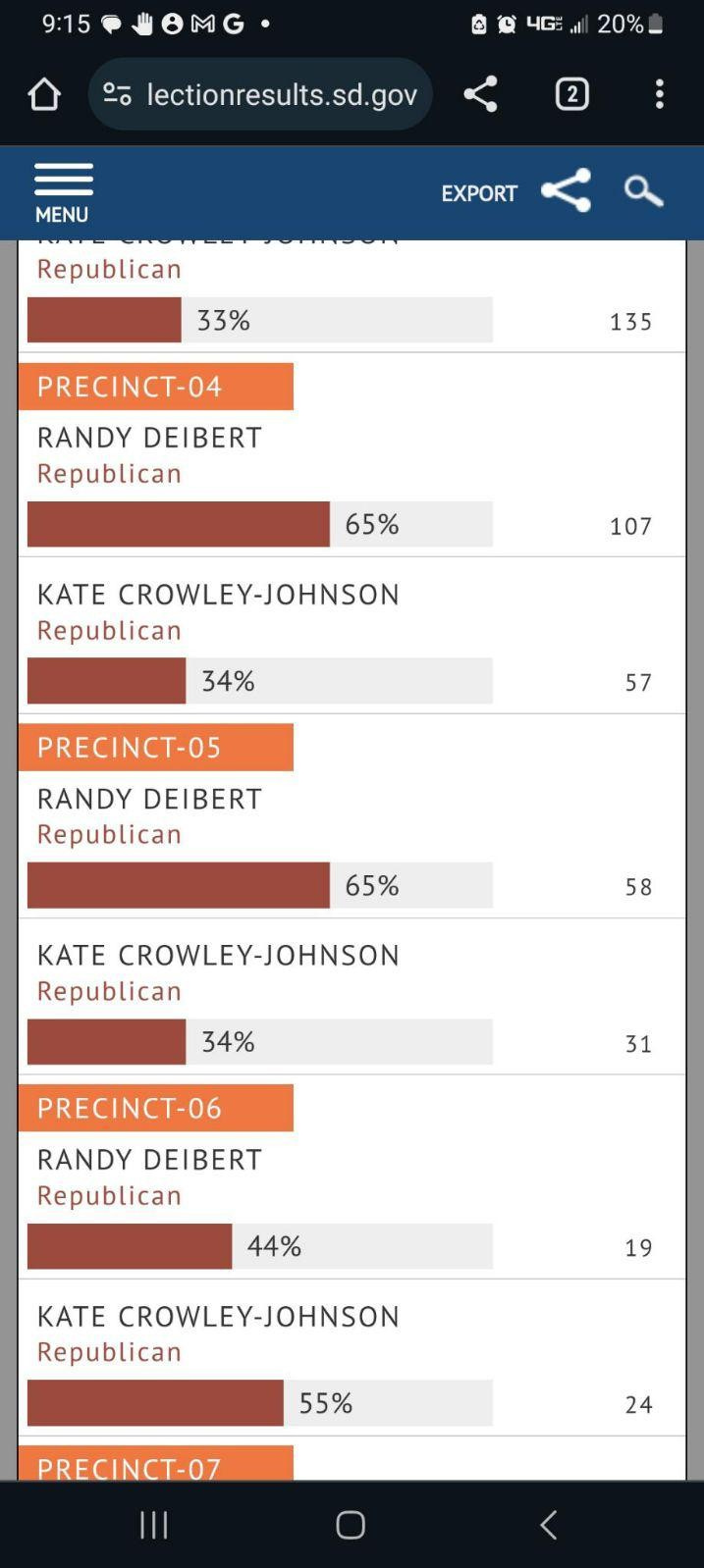
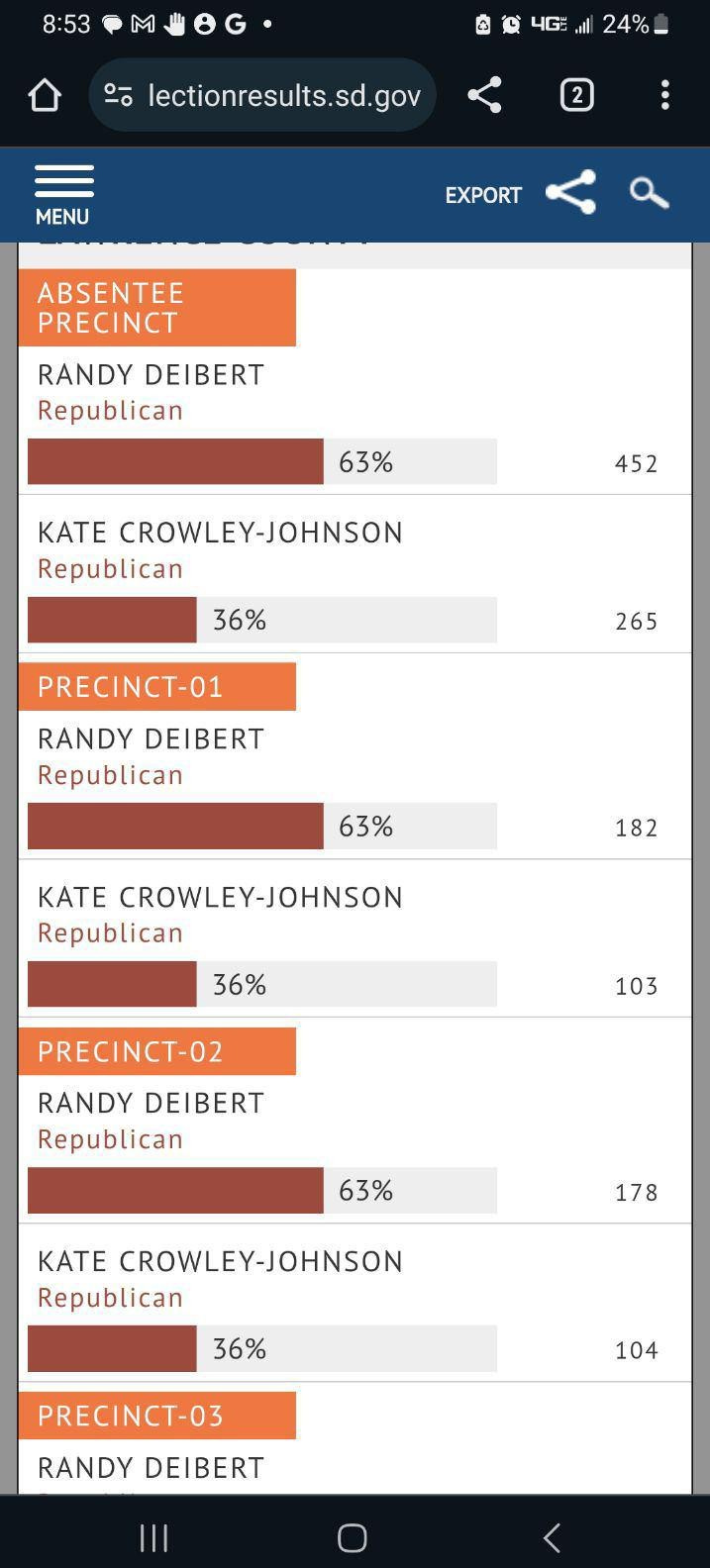
South Dakota Secretary of State Election Rule 5:02:09:01.02. asserts the following, “The person in charge of the election shall conduct tests of the automatic tabulating equipment as required in SDCL 12-17B-5 and 12-17B-12. The test must be conducted by processing a preaudited group of ballots in a test deck marked to record a predetermined number of valid votes for each candidate and each measure. A tally sheet must be created prior to the machine count to show how the sample of ballots is marked and what the machine vote totals must be to prove an errorless count. If more than one ballot is used in the election, a test deck must be made for each ballot that is unique in any way. For each office and ballot question, the test deck must include:
(1) One or more ballots with a vote for each candidate and each side of a ballot question;
(2) One or more ballots with votes in excess of the number allowed by law for each office and question; and
(3) One or more ballots with an undervote;
(4) One or more ballots completely blank to verify that the machine is correctly configured pursuant to SDCL 12-17B-13.1; and
(5) One or more ballots that do not have a ballot stamp.
At least twenty-five test ballots must be included in the total of all test decks. Individual test decks for individual ballots must be of sufficient size to prove the accuracy of the system. If absentee ballots are to be received folded, at least ten percent of the test ballots in any individual test deck must be similarly folded. The person conducting the test of the tabulating equipment shall date and sign the printout, verifying that the results of the machine’s printed paper vote totals exactly match the tally sheet from which the sample of ballots was marked. Any test deck, tally sheet, and signed printout must be secured and retained with the official ballots.
If more than one tabulating machine is to be used in the election, each machine must be fully tested on any ballot which each machine will be used to count in the election.
In addition to these tests, any test deck may be processed any time before or after completion of the official count.
Source: 8 SDR 81, effective January 10, 1982; 21 SDR 77, effective October 24, 1994; 23 SDR 236, effective July 17, 1997; 29 SDR 113, effective January 30, 2003; 33 SDR 230, effective July 1, 2007; 50 SDR 12, effective August 8, 2023.
General Authority: SDCL 12-17B-17(3).
Law Implemented: SDCL 12-17B-5, 12-17B-12.”
The auditor is also required to test different ballot types. The Auditor did not. South Dakota Administrative Rule:5:02:09:01.02. The express vote ballots are different from the hand-filled ballots and more than just one express ballot should have been tested: Administrative Rule:5:02:09:01.02. “If more than one ballot is used in the election, a test deck must be made for each ballot that is unique in any way.”

I believe it is clear that the S.D. constitution should have precedence over state statute SDCL 12-21-10. Pursuant to, “South Dakota Const. art. VII §1 Right to vote. Elections shall be free and equal, and no power, civil or military, shall at any time interfere to prevent the free exercise of the right of suffrage.” This is repeated in our constitution in “South Dakota Const. art. VI §19 Bill of Rights, Free and equal elections–Right of suffrage–Soldier voting. Elections shall be free and equal, and no power, civil or military, shall at any time interfere to prevent the free exercise of the right of suffrage. Soldiers in time of war may vote at their post of duty in or out of the state, under regulations to be prescribed by the Legislature.” The Federal Supremacy Clause allows the SD Constitution precedence. U.S. Article VI, Clause 2: “This Constitution, and the Laws of the United States which shall be made in Pursuance thereof; and all Treaties made, or which shall be made, under the Authority of the United States, shall be the supreme Law of the Land; and the Judges in every State shall be bound thereby, any Thing in the Constitution or Laws of any State to the Contrary notwithstanding.” The U.S. Const. amend. I, confirms I am allowed to petition for grievances. SDCL 12-21-10 is unconstitutional, as it only allows one reason to petition for a recount. I had multiple reasons of illegal conduct by the Election official to petition. My grievance was a factual real wrong done by the Election official called Auditor. To deprive me of a hand recount is completely illegal according to our Federal Civil Rights and our South Dakota Constitution. My petition stated all the multiple laws and administrative rules that the auditor broke when testing the computerized tabulator and I attached the illegal test deck that she used to illegally certify the computerized tabulators. My Verified Petition for a Recount also included the illegal test deck and a document that explains how to read the test deck. Judge Connelly never asked about why exactly it was considered an illegal test deck nor did he mention he read it. I believe there should have been an automatic hand recount authorized and performed as soon as I showed the illegal test deck and state laws to the circuit court. According to “SDCL 12-26-29, the prevention of unlawful elections is not prohibited. “Nothing in this chapter shall be construed to authorize the punishment of any person who, by authority of law, may interfere to prevent or regulate an election which has been unlawfully noticed or convened, or is being, or is about to be, unlawfully conducted.” I followed this statute when I asked in an e-mail to the Auditor and Commissioners to turn on the ballot image function on the computerized tabulators before the primary election of 2024. The County Auditor and Commissioners refused to turn on the ballot image function before the primary 2024 election after they were notified by myself and others that this violated federal law of “All records” preserved for 22 months. I attempted two temporary restraining order affidavits on the computerized tabulator one with a civil complaint pleading. I paid the clerk of courts for two T.R.O.s because the first one was denied. Judge Connelly said I did the first one wrong by not having an existing case so I did another with a civil complaint pleading so I would have an existing case. Judge Connelly denied the T.R.O.s. I did nothing illegal yet the judge allowed the Auditor to break federal laws on record keeping by not preserving the electronic ballot images. The Auditor’s argument is that I am a harasser because I filed multiple suits when she was acting as a serial lawbreaker. I broke absolutely no laws. The Auditor would have us all believe she is the victim in this. The actual victims are the citizens of this state and this county. The Auditor would have you believe I am a harasser as she attempts to place sanctions on me. She believes she is above the law and has the right to conduct illegal elections. Keep in mind I had nothing to do with the Auditor until I realized we had serious issues with our elections. Two of the cases were my statutory and constitutional rights as a candidate. The auditor and commissioners are attempting to put sanctions on me because I used my candidate’s statutory and constitutional rights. These serial lawbreakers want to punish me for exposing their illegal activities. Another reminder according to “SDCL 12-26-29, the prevention of unlawful elections is not prohibited and the Auditor was bound and determined not to follow federal and state laws. In South Dakota, election officials claim we vote on paper ballots but they never reconcile them with the digital image count. Because South Dakota conducts electronic elections, deleting ballot images is deleting the records that the election was certified to. It is not certified to the actual physical ballot. Deleting federal election material is a federal crime. Before the primary election on June 4th, 2025 the Secretary of State Monea Johnson advised all auditors to delete the ballot images by turning off the ballot image capture option. It was very easy for her to advise for this illegal action because she can’t be held responsible because it is the auditors’ responsibility; therefore, the auditors are liable. Myself and others warned the auditors. Our Auditor chose to not listen to the letter written by expert Rick Weible on May 17, 2024 that was sent to all auditors. This letter went into great detail of why it is unlawful to not turn on the ballot image function. This is subsequent to the following:
(a) Pursuant to Federal 52 USC 20701: “Retention and preservation of records and papers by officers of elections; deposit with custodian; penalty for violation Every officer of election shall retain and preserve, for a period of twenty-two months from the date of any general, special, or primary election of which candidates for the office of President, Vice President, presidential elector, Member of the Senate, Member of the House of Representatives, or Resident Commissioner from the Commonwealth of Puerto Rico are voted for, all records and papers which come into his possession relating to any application, registration, payment of poll tax, or other act requisite to voting in such election, except that, when required by law, such records and papers may be delivered to another officer of election and except that, if a State or the Commonwealth of Puerto Rico designates a custodian to retain and preserve these records and papers at a specified place, then such records and papers may be deposited with such custodian, and the duty to retain and preserve any record or paper so deposited shall devolve upon such custodian. Any officer of election or custodian who willfully fails to comply with this section shall be fined not more than $1,000 or imprisoned not more than one year, or both.”
This Federal Law uses the term “all records”.
(b) Pursuant to Federal Law 52 USC 20702: “We are cautioned against destroying, concealing, or altering any record.
52 USC 20702: “Theft, destruction, concealment, mutilation, or alteration of records or papers; penalties Any person, whether or not an officer of election or custodian, who
willfully steals, destroys, conceals, mutilates, or alters any record or paper required by section 20701 of this title to be retained and preserved shall be fined not more than $1,000 or imprisoned not more than one year, or both.”
(c) Pursuant to 52 USC 20706, “ it is clear who is held accountable here: “Officer of election” defined as used in this chapter, the term “officer of election” means any person who, under color of any Federal, State, Commonwealth, or local law, statute, ordinance, regulation, authority, custom, or usage, performs or is authorized to perform any function, duty, or task in connection with any application, registration, payment of poll tax, or other act requisite to voting in any general, special, or primary election at which votes are cast for candidates for the office of President, Vice President, presidential elector, Member of the Senate, Member of the House of Representatives, or Resident Commissioner from the Commonwealth of Puerto Rico.”
(d) Pursuant to SDCL 12-26-23.1, “is a warning about our own enforcement mechanisms regarding the recording of votes, the very idea of turning off ballot images from being saved, is an affront to the maintaining of the records. Tampering with automatic ballot counting devices, direct recording electronic voting machines, and electronic ballot marking systems as felony. No person may intentionally program or alter an automatic ballot counting device, direct recording electronic voting machine, or electronic ballot marking system to erroneously mark, record, or count voted ballots or to render an erroneous total. A violation of this section is a Class 5 felony.” Source: 12-26-23.1 | South Dakota Legislature (sdlegislature.gov)
(e) Additionally, the VVSG 1.1 was adopted by South Dakota, requiring the following: 2.1.10 Data Retention
(f) Pursuant to the US Department of Justice, in their recent publication, Federal Law Constraints on Post-Election “Audits”, Published July 28th, 2021, gives straight forward direction on record retention requirements, which is inclusive to be “all records”. The Civil Rights Act of 1960, now codified at 52 U.S.C. §§ 20701-20706, governs certain “federal election records.” Section 301 of the Act requires state and local election officials to “retain and preserve” all records relating to any “act requisite to voting” for twenty-two months after the conduct of “any general, special, or primary election” at which citizens vote for “President, Vice President, presidential elector, Member of the Senate, [or] Member of the House of Representatives,” 52 U.S.C. § 20701. The materials covered by Section 301 extend beyond “papers” to include other “records.” Jurisdictions must therefore also retain and preserve records created in digital or electronic form. The ultimate purpose of the Civil Rights Act’s preservation and retention requirements for federal elections records is to “secure a more effective protection of the right to vote.” State of Ala. ex rel. Gallion v. Rogers, 187 F. Supp. 848, 853 (M.D. Ala. 1960) (citing H.R. Rep. 956, 86th Cong., 1st Sess. 7 (1959)), aff’d sub nom. Dinkens v. Attorney General, 285 F.2d 430 (5th Cir. 1961) (per curium). The Act protects the right to vote by ensuring that federal elections’ records remain available in a form that allows for the Department to investigate and prosecute both civil and criminal elections matters under federal law. The Federal Prosecution of Election Offenses, Eighth Edition 2017 explains
that “[t]he detection, investigation, and proof of election crimes – and in many instances Voting Rights Act violations –often depend[s] on documentation generated during the voter registration, voting, tabulation, and election certification processes.” Id. at 75. It provides that “all documents and records that may be relevant to the detection or prosecution of federal civil rights or election crimes must be maintained if the documents or records were generated in connection with an election that included one or more federal candidates.” The duty to retain and preserve election records necessarily requires that elections officials maintain the security and integrity of those records and their attendant chain of custody, so that a complete and uncompromised record of federal elections can be reliably accessed and used in federal law enforcement matters. Where election records leave the control of elections officials, the systems for maintaining the security, integrity, and chain of custody of those records can easily be broken. Moreover, where elections records are no longer under the control of elections officials, this can lead to a significant risk of the records being lost, stolen, altered, compromised, or destroyed. This risk is exacerbated if the election records are given to private actors who have neither experience nor expertise in handling such records and who are unfamiliar with the obligations imposed by federal law.
(g) Pursuant to election expert and IT expert Rick Weible’s letter on May 17, 2024 before the June 4th primary election, to the Secretary of State and Auditors, our county auditor is violating Federal and State law concerning keeping “all records”. I attached a written statement by expert Rick Weible that supported turning on the ballot images. The ballot images are necessary to audit the tabulators. The presence of a physical ballot does not tell us how the machine read the ballot. For example, if a crease in an absentee ballot caused the computer tabulator to read the ballot wrong this ballot image function will tell us. Lawrence County also does not have the software to read the ballot images. This is a solid reason to hand recount this contest.
Pursuant to Roudebush v. Hartke, 405 U.S. 15, 92 S.Ct. 804, 31 L.Ed.2d. 1 (1972), “There are two fundamental principles that must be understood in order that there might be a proper analysis of this case. First, there is the question concerning “who” won the election, which necessarily carries with it an inquiry into how the winner was selected. The following questions are mutually exclusive. The questions “of who won” and the propriety of the election procedure are purely matters of state law.” According to Thorsness v. Daschle, 279 N>W.2d 166 (1979) South Dakota Supreme Court, “if a defeated candidate has a question regarding the correctness of the ballot-counting procedure. The final step for a candidate is an application for a writ of certiorari to this court. To deprive him of this is to deprive him of his statutory right and his standing to question the accuracy of the voting process.” Additionally, the SD Supreme Court’s opinion stated the following, “the grievances brought to this court by Thorsness are substantial.” I, am going to stand up for myself by stating this on the record, that if the Thorsness case was considered substantial then mine definitely should be and should not be dismissed because I have the confidence, that I can prove the Auditor achieved approximately 100 violations of several laws. I can prove this with witnesses, documents, experts, and video. The standard of reasonable grounds is greater than reasonable suspicion. Therefore, my grounds are reasonable. I was deprived of a writ of certiorari. Lastly, the commissioners are canvassing their own races. The commissioners lack ethics and should not have canvassed their own election of the primary on June 4th, 2025. “SDCL 6-1-17. Official prohibited from discussing or voting on the issue if a conflict of interest exists–Legal remedy.
No county, municipal, or school official may participate in discussing or vote on any issue in which the official has a conflict of interest. Each official shall decide if any potential conflict of interest requires such official to be disqualified from participating in discussion or voting. However, no such official may participate in discussing or vote on an issue if the following circumstances apply:
(1) The official has a direct pecuniary interest in the matter before the governing body; or
(2) At least two-thirds of the governing body votes that an official has an identifiable conflict of interest that should prohibit such official from voting on a specific matter.
If an official with a direct pecuniary interest participates in discussion or votes on a matter before the governing body, the legal sole remedy is to invalidate that official’s vote.”
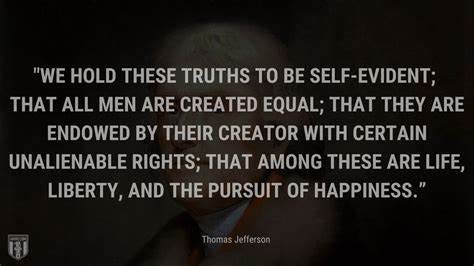
According to the Carter Center, “The observance of the principle of universal suffrage means: a) every citizen, upon coming up to the age fixed by the U.S. Constitution, and laws, has the right to elect and to be elected to the bodies of state power, to local self-governments, other bodies of people’s (national) representation, to elective posts on the conditions and in line with procedures stipulated by the Constitution and laws.” https://eos.cartercenter.org/summaries/321
Universal full suffrage includes both the right to vote, also called active suffrage, and the right to be elected, also called passive suffrage. I believe passive suffrage, Color of Law, and Equal Protection Clause were violated andcaused damages.
This illegal primary election would qualify under the U.S. Civil Rights, TITLE 52—VOTING AND ELECTIONS 10101; Interference with freedom of elections under the color of law is a violation. The Auditor interfered with the freedom of elections under the color of law, and I would add that she was aided and abetted by the commissioners serving on the canvassing board.
According to https://en.wikipedia.org/wiki/Universal_suffrage, “In the United States, after the principle of “One person, one vote” was established in the early 1960s by the U.S. Supreme Court under Earl Warren, the U.S. Congress, together with the Warren Court, continued to protect and expand the voting rights of all Americans, especially African Americans, through the Civil Rights Act of 1964, Voting Rights Act of 1965 and several Supreme Court rulings. In addition, the term “suffrage” is also associated specifically with women’s suffrage in the United States; a movement to extend the franchise to women began in the mid-19th century and culminated in 1920, when the United States ratified the Nineteenth Amendment to the United States Constitution, guaranteeing the right of women to vote.” Under the Oxford Constitutional Law Max Planck Encyclopedia of Comparative Constitutional Law, the definition of passive suffrage is as follows: “The term ‘suffrage’, in its basic form, refers to the right to vote, normally in elections. However, a wider definition also includes the right to vote in referendums and to participate in citizens’ initiatives (direct democracy). Full suffrage refers to the right to vote (active suffrage) and the right to run for election (passive suffrage). Universal suffrage refers to the right to vote without any restrictions based on factors such as gender, ethnicity, and social status.”
“Passive Suffrage” would fall under the Civil Rights Act of 1964, Voting Rights Act of 1965, and several Supreme Court rulings. gender, ethnicity, and social status have the right to run for office and to be elected. This suffrage can be applied to a candidate who was not allowed a fair and equal election because the Auditor and the commissioners who violated the color of law and the equal protection of law.
The Justia Law website states, “Voting is critical to a healthy democracy. Drafted in the aftermath of the Civil War, the Fifteenth Amendment to the U.S. Constitution provides that the right to vote shall not be denied or abridged…on account of race, color, or previous condition of servitude.” Despite this mandate, African-Americans often continued to face institutional barriers to voting, such as poll taxes and literacy tests. Nearly a century later, Congress sought to enforce the Fifteenth Amendment guarantee through the Voting Rights Act. This law banned literacy tests and certain other tools of disenfranchisement. (The Twenty-Fourth Amendment had banned poll taxes in federal elections a few years earlier.) In addition, the Voting Rights Act imposed a specific requirement for jurisdictions with a pattern of voter suppression. No change in voting procedures could take effect in these jurisdictions until it was approved by federal authorities in a process known as preclearance.” This was cited from https://supreme.justia.com/cases-by-topic/voting-elections/
This would mean the “Passive Suffrage of candidates is to have a fair and equal election and would be protected by the Civil Rights Act of 1964 and the Voting Rights Act of 1965. Here is a list of some of the compatible Supreme Court Cases regarding candidates’ Civil rights on “Passive Suffrage” and the “Equal Protection clause” of the U.S. Const. amend. XIV.
1. Bush v. Gore, 531 U.S. 98 (2000), “The use of standardless manual recounts after a presidential election violated the Equal Protection Clause.”
2. Chiafalo v. Washington, 591 U.S. (2020), “A state may enforce an elector’s pledge to support their party’s nominee (and the state voters’ choice) for President.
3. McCutcheon v. FEC, 572 U.S. 185 (2014), “Congress may regulate campaign contributions to protect against corruption or the appearance of corruption, but it may not regulate contributions simply to reduce the amount of money in politics, or to restrict the political participation of some in order to enhance the relative influence of others.”
4. Buckley v. Valeo, 424 U.S. 1 (1976), “Restrictions on individual contributions to political campaigns and candidates did not violate the First Amendment. However, restrictions on independent expenditures in campaigns, limits on expenditures by candidates from their personal or family resources, and limits on total campaign expenditures violated the First Amendment. Also, any appointee exercising significant authority pursuant to the laws of the United States is an “Officer of the United States” and must be appointed in the manner prescribed by the Appointments Clause.”
“The Equal Protection Clause is part of the 14th Amendment to the United States Constitution, which was ratified in 1868. It states that no state shall deny to any person within its jurisdiction the equal protection of the laws. This clause serves as a fundamental principle in U.S. law, ensuring that individuals are treated equally and fairly, and it acts as a shield against discrimination. Originally intended to protect the rights of newly freed slaves, its broad wording has allowed it to be applied in various contexts, addressing issues of race, gender, and other forms of discrimination.” This was cited from https://en.wikipedia.org/wiki/Equal_Protection_Clause.
A candidate should be treated with equal protection of the law. I was not treated equally and fairly by Judge Connelly or by the Auditor as a candidate and a citizen. Instead, my statutory, constitutional, and civil rights were violated by not being allowed to have a legal election. The Bush v. Gore, 531 U.S. 98 (2000) (election recounts) is a distinct referenced case law when describing “equal protection” under the laws.
The following is cited from https://supreme.justia.com/cases-by-topic/voting-elections/ : “The Fourteenth Amendment addresses many aspects of citizenship and the rights of citizens. The most commonly used — and frequently litigated — phrase in the amendment is “equal protection of the laws”, which figures prominently in a wide variety of landmark cases, including Brown v. Board of Education (racial discrimination), Bush v. Gore (election recounts), Reed v. Reed (gender discrimination), and University of California v. Bakke (racial quotas in education)”.
In conclusion, on the Civil Rights “Passive Suffrage,” a candidate should not be suppressed by illicit activities by an auditor. The Bush v. Gore, 531 U.S. 98 (2000) (election recounts) is distinctly referenced when describing “equal protection” to the laws. Please note that Bush v Gore was expedited when my S.D. Fourth Circuit Court case was unreasonably extended.
The Black’s Law Dictionary 12th edition interpretation of the “Color of Law” is the following: “Implies a misuse of power made possible because the wrongdoer is clothed with the authority of the state.” By the Auditor illegally certifying the tabulators, the Auditor directly misused her power as the wrongdoer who is clothed with the authority of an election official.
The following are definitions in the Black Law Dictionary, 12th edition;
“Certifiable, adj. (1846)1. Good enough to be approved according to established standards<certifiable as sterling silver.> 2. Undeniable of a particular kind or status.”
“Certificate, n. (15c)1. A document certifying the bearer’s status or authorization to act in a specific way.”
“Certificate of authority 2. A document issued by a state agency.- Also termed (in some states) certificate of qualifications.”
Certifying the tabulators should be taken seriously. The S.D. Legislature does not enforce the laws, and Judge Connelly in the Fourth Circuit Court was supposed to, but instead found every excuse not to. The testing rules and laws the auditors are supposed to use are in place to prove that the tabulators are certifiable. The tabulators were never proven to be certifiable using an illegal test deck. Due to this, the primary election was not qualified to be legally certified by the Auditor with her signature and her official stamp. One example of a previous South Dakota Supreme Court case that dealt with the seriousness of the action of certification is Jarman vs the State of South Dakota 860 N.W.2d 1 (S.D. 2015).” Certification to this state of S.D. is important.
The following statute on how to authenticate evidence is comparable to the testing statutes that should have been followed. “SDCL 19-19-901. Authenticating or identifying evidence.
“(a) In general. To satisfy the requirement of authenticating or identifying an item of evidence, the proponent must produce evidence sufficient to support a finding that the item is what the proponent claims it is. (9) Evidence about a process or system. Evidence describing a process or system and showing that it produces an accurate result.
(10) Methods provided by a statute or rule. Any method of authentication or identification allowed by a state statute or a rule prescribed by the Supreme Court.” The Fourth Circuit Court ignored my evidence of the illegal test deck and illegal certification.”
According to S.D. Const. art. IX § 1, Lawrence County registered as a corporation only exists because the state allows it to exist. An auditor would be considered very compatible with a state officer as is a county commissioner. The auditor who is elected and receives state benefits of health and retirement would qualify as similar to a stateofficer. An auditor is required to conduct a state and federal election by state and federal laws. The Auditor has taken a written oath to the S.D. Constitution and the Federal Constitution. She was required to conduct a legal county, state, and federal election. This primary had a federal race that was also tested illegally. This duty of conducting not only a county but a state and federal election is acting in the capacity of a state officer with an oath to the state and federal constitution. Judge Connelly mentioned SDCL15-6-24(c) at the hearing as an excuse to dismiss and it says “When the constitutionality of an act of the Legislature affecting the public interest is drawn in question in any action to which the state or an officer, agency, or employee of the state is not a party, the party asserting the unconstitutionality of the act shall notify the attorney general thereof within such time as to afford him the opportunity to intervene.” The key words in this, “the stateor an officer, agency, or employee of the state is “not the party”. The auditor is a party and is an officer of the county that is only in existence because the state allows it to exist,I was not required to notify the S.D. Attorney General. The Federal civil procedure Confirms this in Rule 5.1.(1b) “Constitutional Challenge to a Statute.
(1) file a notice of constitutional question stating the question and identifying the paper
(2) that raises it, if:
(b) a state statute is questioned, and the parties do not include the state, one of its agencies, or one of its officers or employees in an official capacity.
Judge Connelly and Mr. Williams’s argument does not include paragraph (d) of federal procedural Civil Rule 5.1 (2d) No Forfeiture. “A party’s failure to file and serve the notice, or the court’s failure to certify, does not forfeit a constitutional claim or defense that is otherwise timely asserted. This means failure to file or serve notice or Judge Connelly’s failure to certify does not forfeit a constitutional claim against SDCL 12-21-10.” The reason this does not forfeit is that we have the due process rights of the U.S. Const. V and the U.S. Const. amend. XIV. While the Attorney General holds a position of immense authority, it is important to note that they are not necessarily considered the highest rank within our legal system. The true pinnacle of power lies within the judicial branch. The S.D. Supreme Court has the authority to make a decision on a constitutional challenge of SDCL 12-21-10. I believe that this legal question of SDCL 12-21-10 should be addressed by the S.D. Supreme Court and not just swept under the rug because this issue can happen again. Despite SDCL15-6-24(c), there are larger legal issues. Starting with the fact that the Auditor broke S.D. Const. art. VII §1 and S.D. art. VI §19 Bill of Rights by breaking the laws of testing. The other larger issues are my state and federal constitutional rights, and my “Passive Suffrage Civil Rights” that were and still are being violated.
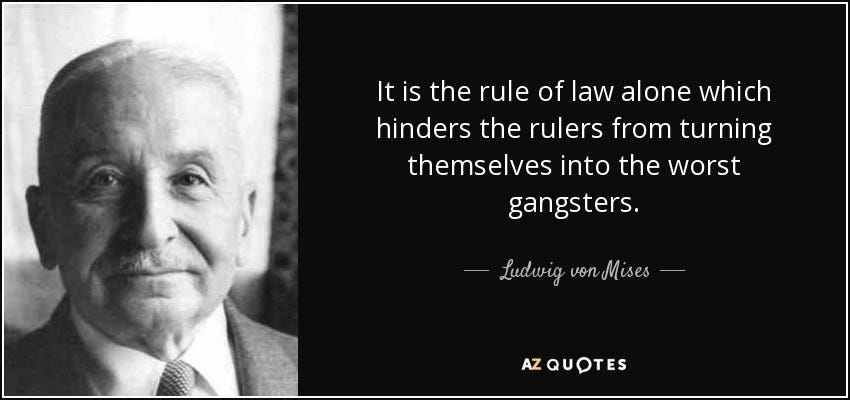
Last but not least is the fact that Judge Connelly should be following
“The Rule of Law” when making a decision, and he did not. The Legislature has noauthority to answer legal questions. The “Rule of Law cannot ever be entirely separate from the people who make up our government and our society.
The American Bar Association has this to say, “In 1215, King John of England signed the Magna Carta (or Great Charter). A group of barons, powerful noblemen who supported the king in exchange for estates of land, demanded that the king sign the charter to recognize their rights. Article 39 of the Magna Carta was written to ensure that the life, liberty, or property of free subjects of the king could not be arbitrarily taken away. Instead, the lawful judgment of the subject’s peers or the law of the land had to be followed. So what does this ancient document have to do with the rule of law? Quite a lot. It recognizes that a person’s fate should not be in the hands of a single individual—here, the king. It demands that a judgment against a person be made in accordance with the law. Magna Carta planted the seeds for the concept of due process as it developed first in England, and then in the United States. Due process means that everyone is entitled to a fair and impartial hearing to determine their legal rights. “If men were angels, no government would be necessary. In framing a government which is to be administered by men over men, the great difficulty lies in this: you must first enable the government to control the governed; and in the next place oblige it to control itself.” James Madison Federalist Paper No. 51 (1788) James Madison’s quote from the Federalist Papers gets at the heart of the problem that even a government of law is ultimately “administered by men over men.” The framers of the U.S. Constitution addressed this problem by dividing power among the different branches of government (legislative, executive, and judicial). This framework for government, known as the separation of powers, ensures that no one person is able to gain absolute power and stand above the law. Each branch of our government has some level of control or oversight over the actions of the other branches.” This was cited from https://www.americanbar.org/advocacy/global-programs/who-we-are/rule-law-initiative/what-is-rule-of-law/
The Fourth Circuit Court was the jurisdiction for the “Recount Petition” I also had standing that now is being deprived. I was not required to go directly to the S.D. Legislature. The Fourth Circuit Court and the Auditor have violated my civil, constitutional, and statutory rights by abusing the Color of Law, Rule of Law, and the Equal Protection Clause.
According to https://www.britannica.com/topic/rule-of-law, “The rule of law is a fundamental principle that ensures all individuals and institutions are accountable to the same laws, which are applied equally and fairly. It supports the equality of all citizens before the law and prevents the arbitrary use of power, thereby securing a non-arbitrary form of government. The rule of law encompasses several key principles, including accountability, just law, open government, and accessible and impartial justice. Historically, it emphasizes that no one is above the law, ensuring that everyone, regardless of wealth or social position, is treated equally.”
This entire primary election deserved an investigation pursuant to Roudebush v. Hartke, 405 U.S. 15, 92 S.Ct. 804, 31 L.Ed.2d. 1 (1972) and Thorsness v. Daschle, 279 N>W.2d 166 (1979). Investigations are a part of verified complaints on contested elections. The Contest Case of Crowley-Johnson vs Deibert appeal NO.30877 (2025) should not have been dismissed by the S.D. Supreme Court, based upon lies in the Defendant’s motion. I followed all the Contest statutes. It was the Fourth Circuit Court and the Supreme Court that did not follow multiple Contest statutes. It was the Fourth Circuit Court and the Supreme Court that did not bring in my legislative contested case as the statutes plainly stated. My Contest Case was delayed by the Fourth Circuit Court. Our county deserved to know if there were damages done by the illegal test deck provided by ES&S and the Auditor. It is disgusting and appalling that an auditor and a tabulator company that is under contract for thousands of dollars with our county can hide behind the court system to violate our entire S.D. citizens’ constitutional rights and my civil right of Passive Suffrage. To this day, Lawrence County has not held ES&S liable for breach of contract when they provided an illegal test deck to the Auditor with her input to ES&S.
Conclusion
The relief sought was and still is a hand recount. The hand count should be allowed to see how much damage was caused. This is the reason auditors are required to keep election records for 22 months. By the Civil Rights Act these records are to be kept to investigate elections. The amount of total damages should not be hidden but should be transparent. The Fourth Circuit Court did not expedite my Recount Petition nor the Contested Verified Complaint according to the statute SDCL 12-22-18 to expedite. Statement issues or legal questions are now added in this brief in hopes that the S.D. Supreme Court will give clarification and relief on the constitutional Verified Petition Recount based on justified grounds. This relief of answering these issues would have saved and will save future stress, time, and money. I had expenditures, and these are damages. Relief is sought for damages to my constitutional, statutory rights, and civil rights. The clarification on statement issues will prevent other problems and issues in the future in our state for every citizen and candidates. This is preventative relief. The legislature cannot answer these legal questions. The Fourth Circuit Court was the jurisdiction for a “Recount Petition” and not the legislature, as was stated in Mr. William’s brief on this matter.

